The New Yorker Cover: "The Finish Line."
↑ Fiction-themed New Yorker cover.
Art Direction: Françoise Mouly

↑ Fiction-themed New Yorker cover.
Art Direction: Françoise Mouly
↑ Newsweek's weekly "two numbers" column alleges "Americans are nearly as likely to believe in intelligent aliens as they are in evolution."
Art Direction: Jessica Fitzgerald
↑ The New Yorker's Review of the film, Spotlight.
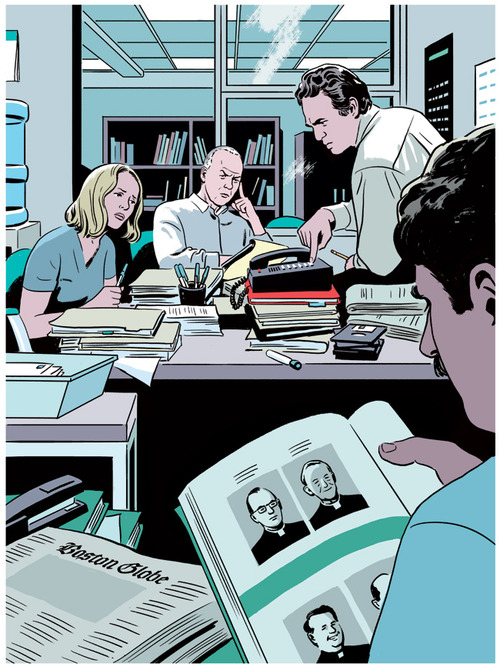 ↑ Rachel McAdams, Michael Keaton, Mark Ruffalo, and Brian d’Arcy James play Boston Globe reporters in Tom McCarthy’s film.
↑ Rachel McAdams, Michael Keaton, Mark Ruffalo, and Brian d’Arcy James play Boston Globe reporters in Tom McCarthy’s film.
Art Direction: Chris Curry.
↑ Wraparound book jacket illustration. Symphony for the City of the Dead: Dmitri Shostakovich and the Siege of Leningrad by M.T. Anderson.

↑ Unused Sketches.
Art Direction: Matt Roeser
 ↑ The D.I.Y. ethos of indie rock gave rise to the start-up culture of the tech industry according to The Atlantic Monthly.
↑ The D.I.Y. ethos of indie rock gave rise to the start-up culture of the tech industry according to The Atlantic Monthly.
↑ Zines, mixtapes, nerds.
Art Direction: Elisa Glass
↑ Aging celebrities Tom Cruise, Denzel Washington, and Helen Mirren explode onto the cover of the New York Times Summer Movie section.
↑ "This summer's action heros are several shades of gray."
Art direction: Shannon Robertson
↑ A reimagined scene from the broadway musical, "Fun Home" based on Alison Bechdel's graphic novel of the same name.
↑ In print.
↑ An illustration which accompanied the New Yorker's review of "Snowpiercer" last summer.
Thanks to Art Director Chris Curry for thinking of me for such varied assignments!
↑ Comic-illustration to accompany a short essay about a retired tennis champion with Alzheimer's.
Art Direction: Nathan Huang

↑ When Kareem Granton returned home safe after his 5-day disappearance, New York Magazine detailed his adventure in a two page comic-strip.
↑ The story as it appeared in the magazine last spring. ↓
Art Direction: Sheth Karishma
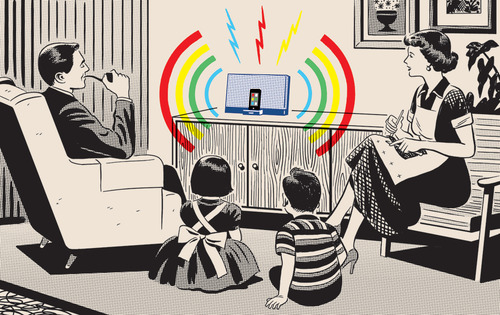 ↑ Entertainment Weekly heralds the podcast Serial as the return of must-listen radio.
↑ Entertainment Weekly heralds the podcast Serial as the return of must-listen radio.
 ↑ Benday dots: they never look right on a screen, but they are just so satisfying in print.
↑ Benday dots: they never look right on a screen, but they are just so satisfying in print.
↑ Sketches.
Art direction: Aaron Morales, Tim Leong
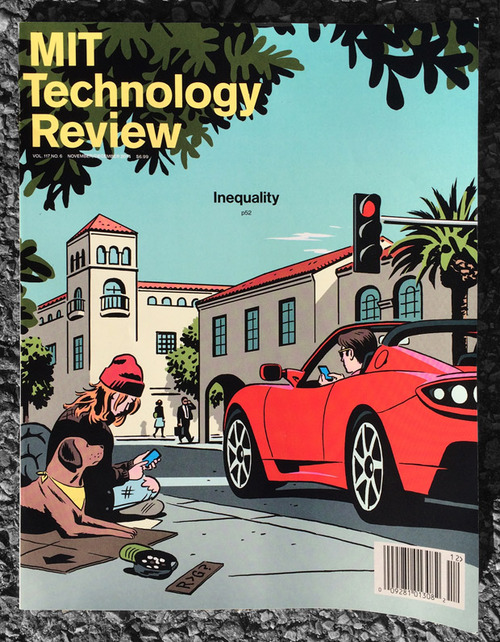 ↑ MIT Technology Review cover article on technology and inequality.
↑ MIT Technology Review cover article on technology and inequality.
↑ "R>G" was a suggestion from the editor. It refers to Thomas Piketty's assertion that R (the return on capital) is historically greater than G (the economic growth rate).
↑ Unused concepts.
Art Direction: Nick Vokey
↑ Wraparound book jacket design with hand lettering.
 ↑ The book features stories about Detroit legends (from left to right) Barry Sanders, Martin Lawrence, Elmore Leonard, Isaiah Thomas, Eminem, Steve Yzerman, Hulk Hogan, And Andre the Giant.
↑ The book features stories about Detroit legends (from left to right) Barry Sanders, Martin Lawrence, Elmore Leonard, Isaiah Thomas, Eminem, Steve Yzerman, Hulk Hogan, And Andre the Giant.
 ↑ Unused sketch.
↑ Unused sketch.
Art Direction: Juliet Litman
↑ Feature illustration for GQ Germany.
Art Director Jana Meier-Roberts and I collaborated on a set of images rethinking a few famously complicated relationships in movies.
↑ A brief interview and documentary clip of my process.
The Hollywood Reporter recently hired me for a project a little out of my normal range: For a Comic-Con themed issue, I drew photographed celebrities into their favorite films.
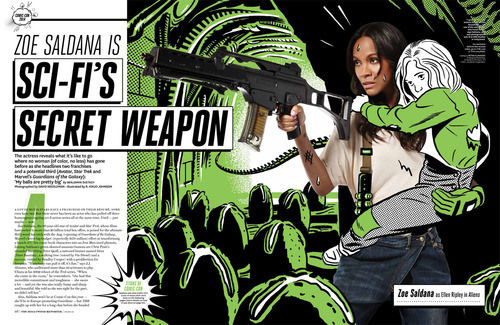 ↑The "Titans of Comic Con" project ultimately became a multi-page photo spread.
↑The "Titans of Comic Con" project ultimately became a multi-page photo spread.
↑The magazine was kind enough to include a sidebar interview about my process.
Art Direction: Shanti Marlar, Christine Park
On May 22nd, I was honored to deliver the commencement address to Parsons' Illustration class of 2014. After thinking long and hard about the kind of speech I needed to hear when I was graduating from college, I decided to tell a first hand account of three young graduates and the very different ways they found their footholds in the industry. Full text below. Special thanks to Todd Lambrix, who invited me to speak, and congratulations class of 2014!
I’m a professional illustrator. In other words, I make drawings all day, and then, people give me money. After eight years of doing this, it’s still crazy to me that this is my reality. I never thought I’d be doing this, even when I was graduating from art school with a degree in illustration. Eight years has been long enough for me to plant my feet, build a body of work, and survive a few ups and downs, but it’s not a long career. I can name a hundred illustrators in New York alone that have bigger names, much more experience, and many more accolades. For this reason, when I was asked to speak here today, I was surprised before I was flattered. But, the more I thought about it, the more I realized that I might have something to offer.
Maybe the point really isn’t professional achievement at all. Whether or not you get paid is, of course, no measure of your success as an artist. To this day, most of my best work I make for myself. Meanwhile, for some of my biggest commissions, I’ve turned in some real doozies. The point is, I’m a guy who loves to draw, and I get to do it everyday with a fair amount of freedom. This modest dream, which not long ago seemed completely unattainable, was actually within reach.
Today, I’d like to share three stories of reaching.
I’ll start in 2002. I was Junior at the Rhode Island School of Design, RISD, studying abroad in Rome. I had recently rediscovered the thing that compelled me to go to art school in the first place: storytelling, specifically, comic book storytelling. I devoured all the comics I could find, but I was no longer attracted the superhero stuff I grew up on. I was digging for the weird, the honest, the dark, the quiet, and the authentic. This was right around the time when the term “graphic novel” began to appear regularly in places like the New York Times and the Library Journal. Comics was undergoing a renaissance, and I felt an energy in the air. In my sketchbook I wondered, “what kind of story could only I tell?”
The second character whose path we’ll follow is my classmate, Paolo, who was with me in Rome. Paolo was that savant in your class who just drew better than everyone else. Some people hated him for it. He was so good, he could draw a likeness of a friend or movie star from memory. Don’t mug Paolo. His crime sketch of you will get you locked up.
Like me, Paolo spent his teens obsessed with comics. The summer before our year in Rome, he went to a comics convention and showed a popular writer his portfolio. The writer hired Paolo on the spot to illustrate a short script about Frankenstein, and as a Junior in college, Paolo was already a professional comic book artist.
The third character in this story is Paolo’s roommate, Ryan. Like Paolo and I, Ryan was a comic book nerd, but more than either of us, Ryan really loved the mythology of super heroes. While we were filling up sketchbooks with ancient ruins and marble sculpture, Ryan was drawing page after page of Captain America and Supergirl. He drew ruins too, but his passion for super heroes was on the page.
Of course, the irony of studying abroad is that by the end of the year, you’ve learned most about the place from which you came. Late one night in Rome, I started writing an account of some events from my high school years. In one sitting, a near complete story poured out in words and doodles. The next day, I started drawing the first pages of a comic book with the working title Night Fisher.
After my year abroad, I went back home to Hawaii with a plan: I would use my summer to finish the projected 60-page comic I started in Rome. I drew during the day, and at night, I worked as a busser at an expensive chain restaurant called "Ruth’s Chris Steak House." September came, and with 40 pages of comics done, I realized it was going to take another 100 pages to tell my story. Against my will, my short comic was becoming a graphic novel.
Paolo finished his Frankenstein comic, and in gratitude, the writer helped arrange a visit to the Marvel Comics offices. This wasn’t a portfolio review though-- this was a courtship. Marvel had already seen Paolo’s talents, and they wanted him. They put him and his parents up in a hotel suite here in New York and planned a lunch with all the editors. Paolo’s biggest dreams were coming true, and being the awesome friend that he was, he asked me to come along.
While Paolo was schmoozing with the editor-in-chief, I was encouraged to sit down with another editor who was known for being open to alternative comics. After he flipped through my portfolio, I could tell he genuinely liked my work. He told me about an upcoming project featuring Ant-man, a superhero that could shrink to the size of a molecule.
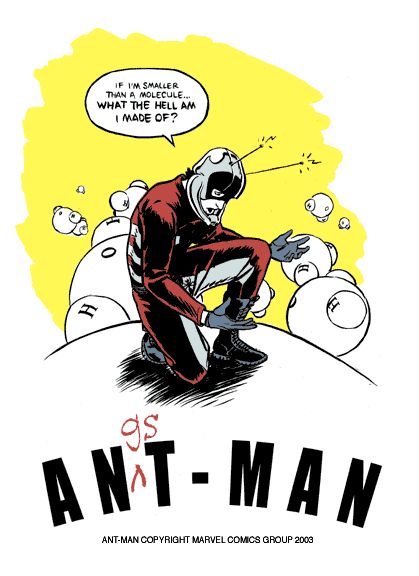
Within a week, I sent the editor a drawing of Ant-man standing on a hokey looking H2O molecule. He was staring at his hands saying, “if I’m smaller than a molecule… what the hell am I made of?!” Remarkably, the editor loved it and asked for more sketches. I did a few more, and he asked for some sample pages. Nothing was sure at this stage, but it seemed like I might get this job if I pursued it. But what about my graphic novel, Night Fisher? I was fifty pages in and desperate to get the rest of my story on paper...
Ultimately, I said no thank you to Marvel and to the potential exposure and security it may have offered. Instead, without any guarantees, I vowed to finish Night Fisher before any other professional pursuit. In hindsight, I can tell you this was best single decision I have ever made.
Back at RISD, Senior year was nearing its end, and Paolo, Ryan, and I shared a gallery for our senior show. I hung up some artsy comics and my unfinished book. Paolo plastered an entire wall with epic oil paintings of Dr. Doom commissioned by Marvel. Ryan printed up some copies of a comic titled, “God Hates Astronauts.” It was a collection of absurd and lurid stories which had almost nothing to do with god or astronauts.
Ryan later told me that after receiving his diploma, he thought to himself, “I went to RISD, and I did well here… my classmate is already working for Marvel… if I’m not drawing comics professionally in 5 years, I’m going to be very upset.”
I went back home to Hawaii, got my old job as a busser, and started up on Night Fisher again. I can say unequivocally that this was one of the most unhappy times of my life. In hindsight, I was very fortunate to have a project and a clear direction to focus on after school, but I was miserable at the restaurant, and I missed my friends. Isolated, I was overwhelmed with doubt. Was my book total crap? Was I wasting my time? Was anybody going to care?
In October, I finally moved to Brooklyn. Paolo and I rented an empty loft space in a former sweatshop and spent months building bedrooms. Our entire kitchen was on castors so we could roll it away to clear space for a dance party when our friends came over. It was good to have friends again.
I walked into to the Ruth’s Chris Steakhouse in Times Square to apply as a busser, and the GM hired me as a server reasoning that, “leaving Hawaii for New York shows gumption.” The money was pretty good, and within a few months, I cut back to just two nights a week. I was scraping by, but I was determined to finish my book.
Around that time, Ryan moved to Boston and got a job at a comic book store. At night, he’d stay up late drawing sample pages to send to Marvel and DC. He never heard back from either company, but he remained undeterred.
Meanwhile, In the room next to me, Paolo landed an exclusive contract with Marvel. He was drawing Spider-man and had health insurance!
This was all just before webcomics had really gained traction and before everyone’s mom had a blog. It was before tumblr and before deviant art. For the most part, unless you were published, you did your work alone, and no one except your closest friends ever saw it. After three long years quietly working on Night Fisher, I finally finished it, printed a copy at Kinkos, and sent it to the one publisher that published all my favorite comics at the time: Fantagraphics. Then, I waited. Weeks passed. I didn’t hear back. There were other publishers I could try, but I knew that none of them was a good fit. I felt defeated; if I wasn’t a comic book artist, I was just poor and a waiter.
It was a very cold winter, and I didn’t have a proper coat. Broke, I meandered toward the clearance rack at a Burlington coat factory. I pulled out a hideous but very warm-looking yellow sheepskin parka and carried it toward the angled mirrors. As I slid my arms through the sleeves, my phone rang. It was the publisher from Fantagraphics. He asked me why I hadn’t answered his emails. Somehow, I hadn’t received them. He said he sent me a contract and that he wanted to publish Night Fisher. I looked up and stared at my reflection head to toe in disgusting yellow sheepskin, and I saw my whole world change.
The thing about alternative comics is that not that many people read them, but many art directors do. The month that Night Fisher was published, I was offered a job illustrating sex positions for Men’s Health magazine. I'm not sure what that says about Night Fisher or my drawing style, but my initial reaction was to say no. I was a “pure artisté,” you see. However, I had been broke for years, and the commission was more than my rent. My second professional job was a two-page feature for the New Yorker. The art director apparently had a copy of Night Fisher on her desk! More magazines began to call, and the gigs got better. Night Fisher got great press and won some awards. It was translated into Spanish and French, and I was even flown back to Italy to promote the Italian edition.
My big break seemed to happen overnight, but building a consistent client base takes a while; I continued waiting tables for years before finally quitting to freelance full-time.
Meanwhile in Boston, Ryan left his job at the comic shop and vowed to never work retail again. He moved to Chicago and got a job designing trade show banners for a local printing company. When printing work dried up, the company sold the presses and filled the entire warehouse with a new line of business: caskets. Ryan’s job became photoshopping brushed metal veneers and velvet interiors onto photos of cheap Chinese caskets.
He still mustered the will to submit new sample pages to Marvel and DC, but just as before, he was met with silence. Five years had passed, and Ryan was not drawing comics professionally. He later told me that one of the hardest parts of the rejection was how it began to impact his friendship with Paolo. Paolo had achieved everything Ryan wanted, and it was increasingly difficult for Ryan to be around that kind of success.
The start of any career is rocky. Starting a career in the arts is mountaineering. The peaks and valleys on your path will almost never coincide with those of your friends, but you have to fight jealousy. A friend will throw you a rope way before an art director will, and at some point, I guarantee that same friend will need help on the climb.
Eventually, Ryan gave up. He realized that all those years he spent submitting pages to Marvel and DC were a waste of time. Despite his RISD degree and the countless hours he spent practicing his craft afterward, he admitted that his drawings simply didn’t have the wow factor to impress the editors in power.
So, Ryan changed course. He dusted off an old copy of God Hates Astronauts and started a new chapter. Instead of doing the Marvel/DC thing, Ryan did his thing. He eventually published it as a webcomic and began to build a following. He networked with friends, shook hands at conventions, and wrote a business plan. Last year, Ryan started a Kickstarter campaign attempting to raise $15,000 dollars to print a hardcover edition. The campaign generated a huge amount of buzz, was covered in USA Today, and ultimately grossed over $75,000 dollars.
Finally, nine years after graduating, Ryan was a professional comic book artist. Publishers who ignored him for his entire adult life were knocking at his door. Ryan even gave his old friend Paolo a call to propose a collaboration. Despite being busy with some of the biggest projects of his career, Paolo eagerly accepted.
To state the obvious, it’s not always easy after college. Students often ask me, “How do I start a career in illustration?” My answer is always the same: “I don’t know.” I don’t know how you’ll start your career in illustration, not because the path is too perilous, but because your path hasn’t been paved yet. When I was midway through Night Fisher, an old pro at a portfolio review flipped through my unfinished book and saw the doubt in my eyes. He told me, “stay at it. You will never regret making this book exactly the way you want to make it.” Not only was that the best artistic advice I’ve ever been given, it was also the best professional advice. I can’t promise that if you just draw your drawings and paint your paintings, recognition and professional security will follow. However, I can promise that you will never regret making the work you want to make. There aren't many success stories in this field that don't involve this step somewhere along the line.
Be yourself, be honest to your vision, make your art, and put it out there. Good luck!
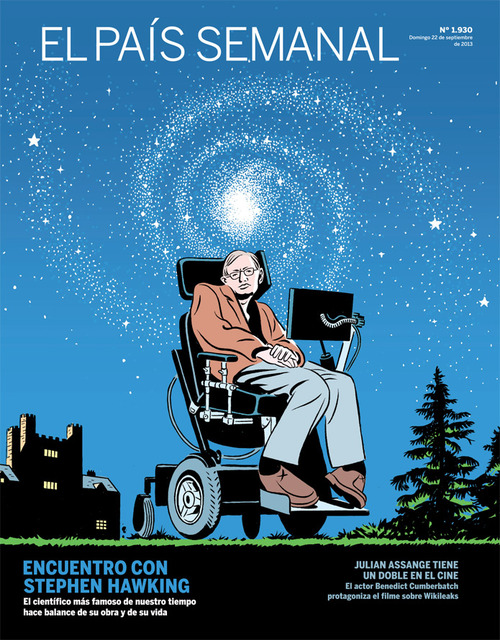 ↑ Art Director Paloma Lorenzo recently commissioned this portrait of Stephen Hawking for the cover the cover of El País Semanal, the Spanish newspaper's weekend magazine supplement.
↑ Art Director Paloma Lorenzo recently commissioned this portrait of Stephen Hawking for the cover the cover of El País Semanal, the Spanish newspaper's weekend magazine supplement.
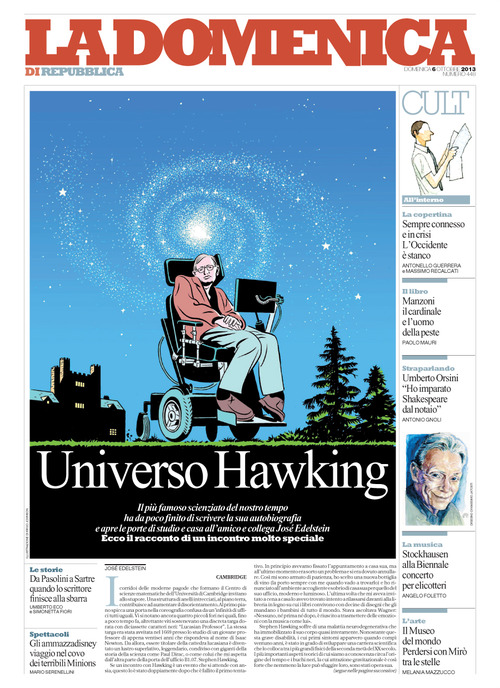 ↑ The image was later purchased by La Reppublica for the Italian translation of Jose Edelstein's article.
↑ The image was later purchased by La Reppublica for the Italian translation of Jose Edelstein's article.
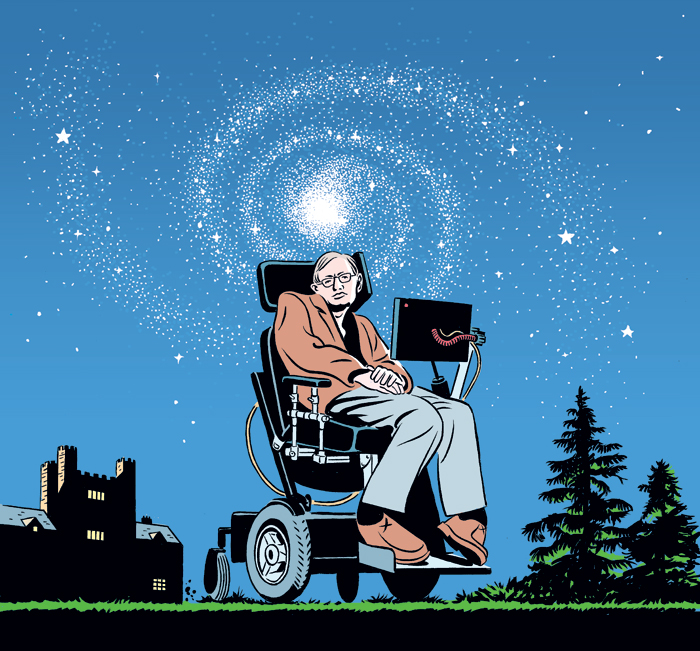
 ↑ Henry David Thoreau and his small cabin at Walden Pond.
↑ Henry David Thoreau and his small cabin at Walden Pond.
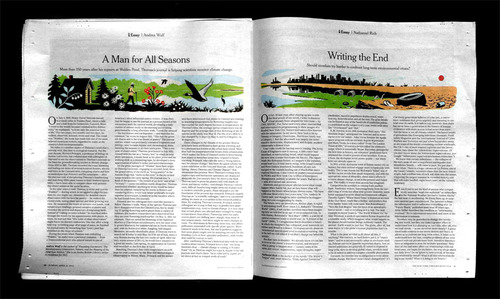 ↑ Two separate articles reviewing books on climate change. Art Director Nicholas Blechman proposed two illustrations that combine to suggest a single narrative.
↑ Two separate articles reviewing books on climate change. Art Director Nicholas Blechman proposed two illustrations that combine to suggest a single narrative.